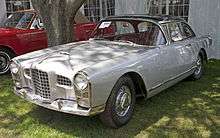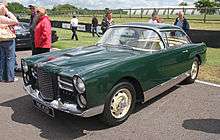Facel Vega FVS
The Facel Vega FV/FVS was a car produced by French carmaker Facel from 1954 to 1959. It continued until 1962 as the HK500.
| Facel Vega FV/FVS/HK500 | |
|---|---|
| Overview | |
| Manufacturer | Facel |
| Also called | Facel Vega HK500 (1959–1962) |
| Production | 1954–1962 |
| Designer | Jean Daninos |
| Body and chassis | |
| Body style | 2-door coupe |
| Layout | Front engine, rear wheel drive |
| Powertrain | |
| Engine | 4,528 cc DeSoto Fire Dome V8 4,768 cc DeSoto Fire Dome V8 4,940 cc Chrysler Poly V8 5,407 cc DeSoto Fire Dome V8 5,801 cc Chrysler Hemi V8 6,279 cc Typhoon V8[1] Chrysler B-383[2] |
| Transmission |
|
| Chronology | |
| Successor | Facel Vega II |
History
FV
The Facel 'Vega' was launched at the 1954 Paris Salon. By 1956 the cars were called FVS (for Facel Vega Sport), earlier cars often being referred to as simply "FV".[3] The 1954 versions of the Facel were fitted with a DeSoto Firedome (Chrysler) 4.5 litre Hemi V8 engine, paired with either Chrysler's two-speed Powerflite automatic transmission or, at extra cost, a four-speed manual made by Pont-à-Mousson.[4] At this stage, the 180 hp (134 kW) FV was capable of a top speed from 172 to 193 km/h (107 to 120 mph), depending on which rear axle ratio was installed. The chassis, designed by Lance Macklin, was tubular framed, featuring coil springs and double wishbones at the front, with a leaf-sprung live rear axle.[1] The styling, by Daninos himself, was somewhat American and perhaps a bit heavy, with rudimentary tail fins. The body was an expanded version of the earlier, Facel-bodied Simca/Ford Comète. An abundance of stainless steel brightwork was fitted.
The interior was uncommonly luxurious, and of exceptional workmanship. The dashboard was aircraft-inspired, and one of the first to feature a middle console over the gearbox. The rear seats folded flat to provide a luggage platform and additional access to the boot.[1] In 1955 the engine capacity increased to 4.8 litres and 200 hp (149 kW) (FV1), which later in the year grew to 250 hp (186 kW) (FV2). 47 of these early FVs were built in 1954 and 1955. Six were convertibles, but as these suffered from rigidity troubles the rest of the large two-door Facels were pillarless coupés.[1]
FVS

The 1956 FVS featured a panoramic (aka wrap-around) windshield. Sometimes referred to as FV2, the car featured the same engine as in the later FV1s. Subsequently the 5.4-litre FV2B appeared, with 255 hp (190 kW). Later versions offered a three-speed automatic, and disc brakes were available from 1958. At some point a reworked, more harmonious front end was introduced, featuring what looked like twin stacked headlights but what were actually headlamps on top and auxiliaries beneath. Power steering and power brakes were both standard as of 1957.[2] For 1958, the engine grew to 5.8 litres (FV4) and 325 hp (242 kW), although the earlier 4.5 and a 4.9 (FV3/FV3B) were also listed as available. In total, 357 FVs and FVSs were built.[3]
A four-door version, called the Excellence, was added to the lineup in 1958, but was even more rarefied than the two-door version.
HK500

For 1959, the Facel Vega HK500[5] was introduced. Essentially, it was just a renamed, upgraded FVS. Equipped at first with the 335 hp (250 kW) 5.8-litre V8 from the FVS, the HK500 soon received a 360 bhp (268 kW) 6.3 litre Chrysler V8, giving it a top speed of 147 mph (237 km/h). It could accelerate from 0-60 mph (97 km/h) in 8.5 seconds.[2] Initially, disc brakes were optional, becoming standard in April, 1960.[3] The Facel Vega II replaced the HK500 in 1962, after 489 had been built. One was a specially made convertible. Total FV/HK production was 842,[2] or 846 depending on the source.
French publisher Michel Gallimard was driving his HK500 on January 4, 1960, when he lost control and crashed outside of Villeblevin. The crash killed him and one of his passengers, Nobel laureate Albert Camus. Some have speculated that the driver was not familiar with the car's handling and weight, and that contributed to the severity of the crash.[6]
| Production[7] | |
|---|---|
| 1954-1955 | 47 (FV) |
| 1956 | 107 (FVS) |
| 1957 | 118 (FVS) |
| 1958 | 85 (FVS) 71 (HK500) |
| 1959 | 190 (HK500) |
| 1960 | 202 (HK500) |
| 1961 | 66 (split between HK500 and Facel II) |
Notes
- Flammang 1994, p. 201.
- Flammang 1994, p. 202.
- Lawrence 1991, p. 111.
- Wood 2002, pp. 58–59.
- "German brochure of HK 500" (JPG) (in German). Archived from the original on 7 January 2018. Retrieved 1 January 2018.
- Bayley, Stephen. "Albert Camus' Crash". Archived from the original on 4 March 2016. Retrieved 5 October 2015.
- From Flammang 1994, pp. 201–203 and Lawrence 1991, p. 111. Some of these numbers vary slightly depending on the source.
References
- Flammang, James M. (1994). Standard Catalog of Imported Cars, 1946-1990. Iola, WI, US: Krause Publications, Inc. ISBN 0-87341-158-7.
- Lawrence, Mike (1991). A to Z of Sports Cars. Bideford, Devon, UK: Bay View Books. p. 111. ISBN 1-870979-81-8.
- Wood, Jonathan (2002). The Ultimate History of Fast Cars. Parragon Books. pp. 58–59. ISBN 1-4054-6068-7.